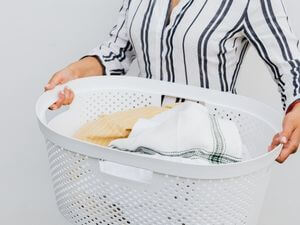Most people assume that you can throw everything into the washing machine all at once provided the clothes do not bleed. However, this is the wrong approach of doing laundry. It leaves most clothes looking messy and old after a few washes. Not to mention, some clothes get covered by lint balls as soon as the first wash.
The Importance Separating and Sorting Laundry

There are several ways in which sorting clothes facilitates your laundry process.
Firstly, most of the clothes remain as good as new. Without a doubt, your nicest clothes are a worthy investment. Whether they cost an arm and a leg, or just a few pennies, you love them and would want to have them in their best condition. Separating them before cleaning allows you to wash them in the right settings and with the appropriate detergent.
Sorting prevents whites from becoming dingily: You will notice that your white colored clothes begin to lose their sparkle after several washes with colored clothes. This happens as a result of a combination of factors.
To begin with, mixing whites with colors prevents you from using the most appropriate detergent. There are detergents that are specifically designed for whites. However, they cannot be used in a load that features colors. Automatically, you have to use a surfactant that is suitable for all kinds of clothes.
Secondly, some whites require presoaking in bleach before washing. Unfortunately, this does not happen when they are mixed with colors. They go directly into the regular wash cycle.
Lastly, unlike most colors, a lot of whites are suitable for washing in hot water. Mixing whites with colors will prompt you to choose the cold water setting because it is gentle on colors.
Separating clothes controls pilling: Most clothes have textures that vary significantly. Accordingly, there are some that produce lint while others do not.
Placing clothes with different textures in the same load creates the problem of lint transfer. Ideally, clothes that do not pill collect lint from those that pill. On the other hand, pilling clothes produce more lint as a result of excessive wear and tear.
Sorting increase the efficiency of washing machine: Following the provided settings allows a washing machine to achieve optimal performance. For instance, if you are washing delicates, it will spin with care to avoid ruining your garments.
Lastly, separating clothes prevents balancing issues: You might have noticed balancing issues after throwing everything into the washer. The culprits are clothes of different weights among other issues.
How to Separate Laundry

Separating laundry is a process that turns into a routine. Once you begin doing it, you never look back. You stick to it every time you do laundry because clothes come out in pristine condition.
Step 1: Read through the care label
It is possible to determine the appropriate washer setting for a garment by just looking at it. However, do not proceed to base your decision on assumptions.
Reading through the care label instructions prevents you from making careless mistakes. Ultimately, you end up protecting your clothes from premature damage by cleaning them in the right way.
Step 2: Sort clothes by color
Undoubtedly, this appears to be the easiest step but it can be quite difficult. At a glace, you look at clothes and determine where to place them by color. However, there are garments of different colors that can be washed together.
Therefore, the first step is to separate whites from bright colors and darks. It is important to always wash whites separately. This allows them to maintain their original brightness.
Secondly, inspect the colors and separate them based on bleeding properties. If you have a new colored garment, do not mix it with the rest during the first wash. Clean it separately so that you can determine whether it is shedding color.
In most cases, new colored clothes shed excess color and dye during the first few washes. However, factors such as type of detergent, water temperature and length of wash cycle determine the rate of shedding.
Thirdly, put darks aside. In most cases, they can be washed together without issues.
Step 3: Separate clothes by fabric
Sorting clothes by fabric is the most important step for preventing wear and tear. Clothes with different fabrics go to different washer settings. Ultimately, this determines the environment that the washer automatically subjects your clothes to inside the drum.
Even if you are washing by hands, this step is fundamental. For example, you cannot mix jeans with light fabrics.
Step 4: Sort clothes by size
Avoid mixing garments with significant variations in size. For example, regular clothes do not belong to the same load with towels and bed sheets.
Ideally, smaller clothes get trapped inside large items. This prevents them from cleaning properly. On the other hand, items such as towels produce a lot of lint. This can cause damage to some regular clothes.
Step 5: Soiling
Clothes might share similar characteristics with respect to color, size and fabric but they do not belong to the same load if there are major differences in soiling.
Remember that you might need to pretreat and presoak garments with heavy staining. Both of these processes require bleach and other harsh cleaning products. It is not necessary to subject clothes that do not need heavy cleaning to such surfactants.
Important tip: Turn all the clothes inside out before washing.
Frequently asked Questions
Is it really necessary to separate laundry?
Separating and sorting clothes is an essential part of doing laundry. It helps preserve colors and the good condition of your clothes. Further, it controls issues such as pilling and premature dulling.
Can grey and whites be washed together?
It is okay to mix some light grey garments with whites in the washer. However, dark greys should be washed in a separate load especially when using bleach for whites.
Is grey light or dark for laundry?
Place light grey in a pile for light clothes. Dark grey clothes belong the pile for darks.
What colors can be washed together?
Colors such as dark grey, black and brown can be washed together. You can also mix lights such as purple, pink, green, yellow and red if you are sure that the garments do not release color and dyes. Lastly, whites and light greys can be washed together.
What happens if you do not separate laundry?
Failure to separate clothes creates the potential for ruining some of them. For example, it is possible to damage whites permanently if colors bleed on them.
Can you dry lights and darks together?
Drying lights and darks together is not a good practice if you desire that your lights maintain their original brightness.





